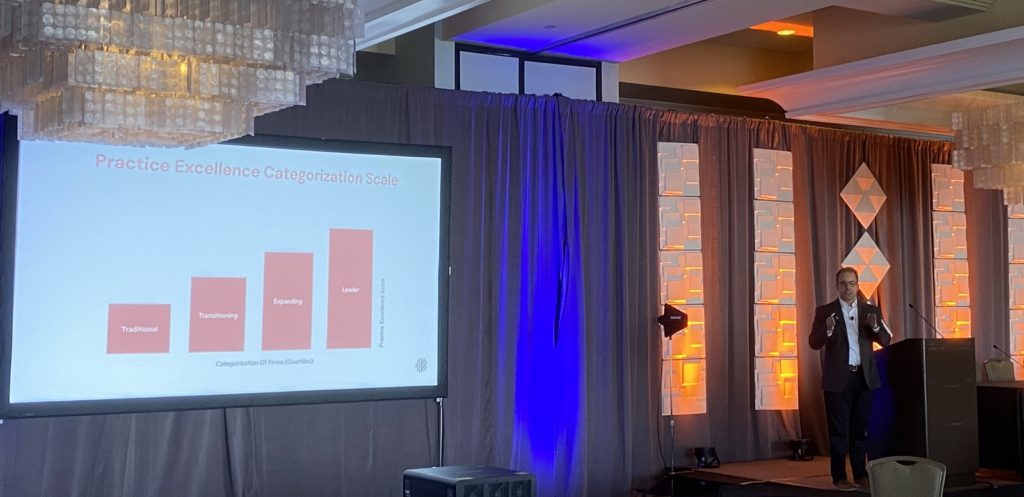Practice Excellence Formula: Learn From the Best


Over the past four years, practice management software company Karbon has polled 1,000 accounting practices to compile its Practice Excellence Assessment and Scorecard, and the findings are worth noting.
Looking at 12 different dimensions of practice (see below), Karbon examined the underlying patterns to construct a framework that distils all the inputs within the firm into a single metric that firms can use to benchmark themselves against their peers.
Each of the 12 Practice Excellence competencies falls into broader strategy pillars illustrated in the chart: strategy in the top quadrant (between 10 and 2 on the clockface), growth (right), operational management (bottom) and efficiency (left). Summing up the composite scores for each firm and plotting them against a scale based on revenue per employee, the developer classifies participating firms into “leaders”, “progressives”, “high performers” and “laggards.”
The object of the exercise is to help all accountants follow in the footsteps of the leading firms by understanding and implementing some of the activities that set them apart.
In recent years, AccountingWEB has collaborated with Karbon’s research, so it fitting that Zach Cochran, customer success manager for North America came to the recent Live Summit in San Diego to unveil the latest findings (pictured above).
The Covid-19 Experience
Karbon continued to poll participating practices throughout the Covid pandemic and the 2022 Practice Excellence report shows how practice behaviours changed during the crisis.
Touching on his own experiences working in practice at the time, Cochran told the audience: “In March 2020 accountants had to become psychologists and experts in things they didn’t know about. It was a hard time. Firms had to figure out how to embrace technology quickly and become more progressive to change how they managed their firms,” he said.
The average Practice Excellence score for the 426 firms taking part in 2022 was 52.5% with the highest rankings showing up in operations management and technology, with marketing and growth the lowest – “still the most difficult” part of the formula, according to Cochran.
Overall, participating firms relied on technology tools the most, and reporting metrics and management techniques the least. This “over-focus” on technology, relative to other initiatives, may be a product of the pandemic, as firms had to rely on technology to get work done, Cochrane explained.
The 2022 report digs deeper into this issue, concluding: “Not all activities have an equal impact on Practice Excellence. In fact, regression analysis, which quantifies the effect of different activities on Practice Excellence, reveals that technology tools actually have relatively little impact on Practice Excellence.”
A Balanced Approach
“When you go from a traditional to transitioning firm, we saw an emphasis on management and efficiency,” explained Cochran. “That [includes] how you coach and train people to make sure they do the right kind of work and communicate with clients in the right way.”
The leading firms sharpen their focus on efficiency as the workload grows. “Once you scale up and invest in your team, it’s a lot easier to experience that growth,” Cochran continued. “It’s a balanced approach. You can’t just go all into growth. Growth will not lead to success of the firm overall if that’s all you focus on. Because without a system or a process, you won’t be able to onboard those clients and take care of them. The same goes for technology.”
Continual innovation and flexibility hold the key to sustaining growth and improvement over time. Accountancy firms need to constantly refine, improve, and reinvent their business strategies to keep growing, he said. And to truly excel, firms must know where to invest to have the maximum impact and balance expertise with behaviour.
Investing in the Right Activities
While the principles of Practice Excellence have been known for several years, the techniques that have the greatest positive impact are used by very few firms. Elite firms involve staff in shaping innovative improvements and use customer relationship management tools to better define client characteristics and communicate more effectively with them. Many more firms developed these skills supporting client businesses through Covid-19. But the ones who deploy them for marketing purposes visibly outperform those who don’t on the Practice Excellence scorecard.
“Activities that identify, define, and engage their target markets are likely to increase expertise and revenue, allowing [firms] to hone in on and address specific pain points that resonate with their target market,” Karbon noted.
The measures that most most correlated to high Practice Excellence scores included:
- Objectives and Key Results (OKRs)
- Monthly Recurring Revenue (MRR)
- Target market selection (niche)
- Client Lifetime Value (LTV)
- 360 performance evaluations
- Net Promoter Score (NPS)
- Ideal client profile (persona)
- Emotional IQ tests
- Standardized staff onboarding
- Email response time.
Close the Leader-Laggard Gap
According to Karbon, tools such as workflow management and business intelligence also help firms to monitor outputs and bottlenecks, and make appropriate adjustments as efficiently as possible.
Within the management pillar, techniques such as OKRs that align staff with the firm’s overall mission and objectives ensure that teams within Leader firms feel invested in the firm and its wider goals.
“Leader firms know and do more–and they’re doing it well, because this is reflected in their revenue per employee,” the study concludes.
The 2022 AccountingWEB Live Summit may be over, but you can join us back in San Diego in 2023! Pre-register today to be the first to know when tickets are on sale. You can find the form at www.accountingweblivesummit.com.

